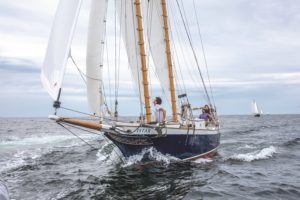GLOUCESTER — The crew of the Istar waited restlessly on Thursday through the aftermath of Tropical Storm Ida. That was the day they had planned to sail from Provincetown to Gloucester for its 37th annual Schooner Festival. Friday evening finally brought favorable winds, and the team set out to arrive just a day ahead of the Mayor’s Cup Race.
“We sailed by the stars,” said Capt. Josiah Mayo. Leaving Provincetown at 6 p.m. and arriving in Gloucester about 1 a.m. meant “a night under the Milky Way and watching shooting stars,” he said. “You can see so much once you’re away from town.”
Mayo’s mate this year was Arman Amirzhan, a family friend and Harvard physicist — “an optics guy who’s working with Stormy on a new plankton measurement apparatus,” said Mayo — who is also an amateur astronomer. Other crew members were Gabriela Bílá and Boston Globe environmental reporter David Abel, who is working on a film about Josiah Mayo and Mike Packard’s recent close encounter with a whale. Istar owner Charles “Stormy” Mayo was the helmsman.

Getting to Gloucester ahead of time is part of the fun, Josiah said. “It’s such a fishy, nautical town, a kind of echo of Provincetown, maybe not as gentrified,” he added. “I love it there.”
The Istar has competed at Gloucester for five years running and for the second time she took second place — this year in a field of nine in the small schooner class.
The starting line is in front of Gloucester Harbor. Competitors round a buoy about 3.5 miles away and return. “That makes it a tactical race,” the captain said. “You have to think about which side of the course will give you an advantage, and how to stay closest to the wind.
“The cool thing about this race,” Mayo added, “is that it’s composed of nearly all traditionally rigged schooners.”
Picture boats with two masts — the larger one in the stern, a smaller foremast, and a little jib up front, and rigged with rope and pulleys. Although a few now have winches and wire stays the way yachts do, the Istar — and most boats competing in the Mayor’s Cup — do not, Mayo explained.
“This is the sail design that built the coastal economy of New England from Colonial times through the age of sail,” he said. “Sailing in this race takes you straight to the 19th century.”



